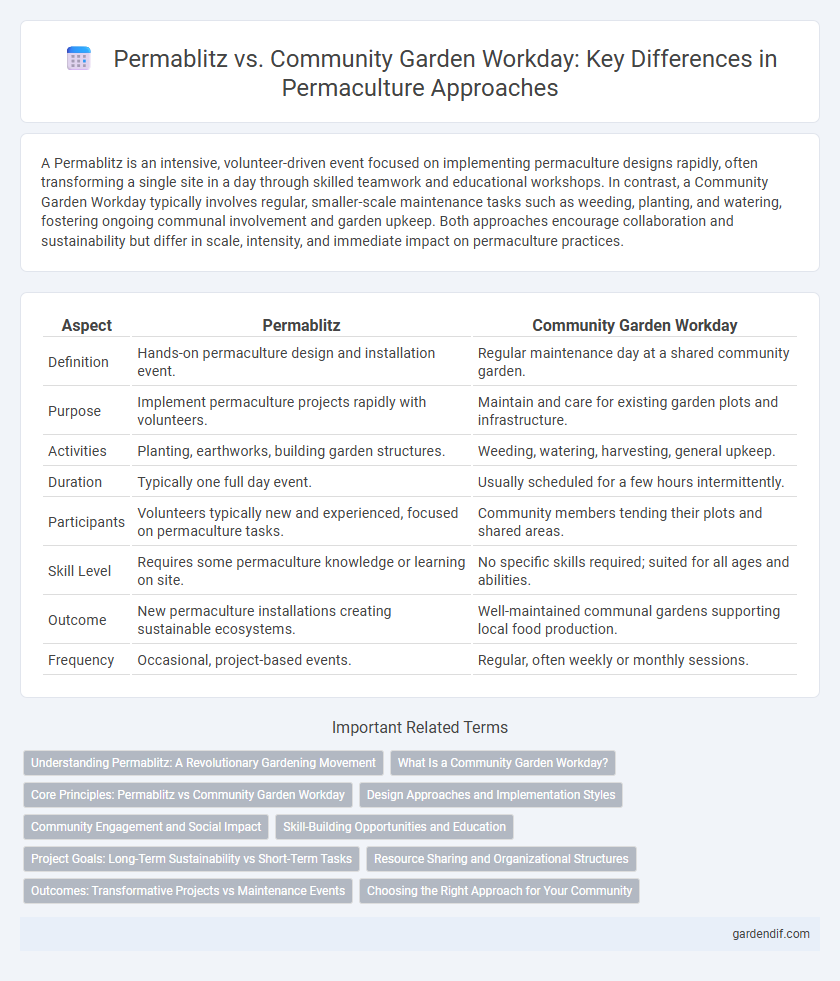
Permablitz vs Community Garden Workday Illustration
A Permablitz is an intensive, volunteer-driven event focused on implementing permaculture designs rapidly, often transforming a single site in a day through skilled teamwork and educational workshops. In contrast, a Community Garden Workday typically involves regular, smaller-scale maintenance tasks such as weeding, planting, and watering, fostering ongoing communal involvement and garden upkeep. Both approaches encourage collaboration and sustainability but differ in scale, intensity, and immediate impact on permaculture practices.
Table of Comparison
| Aspect | Permablitz | Community Garden Workday |
|---|---|---|
| Definition | Hands-on permaculture design and installation event. | Regular maintenance day at a shared community garden. |
| Purpose | Implement permaculture projects rapidly with volunteers. | Maintain and care for existing garden plots and infrastructure. |
| Activities | Planting, earthworks, building garden structures. | Weeding, watering, harvesting, general upkeep. |
| Duration | Typically one full day event. | Usually scheduled for a few hours intermittently. |
| Participants | Volunteers typically new and experienced, focused on permaculture tasks. | Community members tending their plots and shared areas. |
| Skill Level | Requires some permaculture knowledge or learning on site. | No specific skills required; suited for all ages and abilities. |
| Outcome | New permaculture installations creating sustainable ecosystems. | Well-maintained communal gardens supporting local food production. |
| Frequency | Occasional, project-based events. | Regular, often weekly or monthly sessions. |
Understanding Permablitz: A Revolutionary Gardening Movement
Permablitz represents a revolutionary gardening movement that transforms traditional community garden workdays by fostering collaborative, skill-sharing events focused on permaculture principles and sustainable design. Unlike typical community garden workdays centered on routine maintenance, Permablitz gatherings emphasize holistic ecosystem development, soil regeneration, and biodiversity enhancement through hands-on workshops. This approach accelerates local food production, strengthens social networks, and educates participants on ecological stewardship, making it a dynamic model for future urban agriculture initiatives.
What Is a Community Garden Workday?
A Community Garden Workday is a coordinated event where local volunteers and gardeners unite to maintain, plant, and improve shared garden spaces, fostering collaboration and sustainable urban agriculture. These workdays often involve tasks such as soil preparation, planting seasonal crops, weeding, composting, and infrastructure repairs, aligning with permaculture principles of ecological balance and resource efficiency. Unlike permablitzes, which are intensive, skill-sharing events focused on permaculture design implementation, Community Garden Workdays prioritize regular upkeep and community engagement in ongoing garden stewardship.
Core Principles: Permablitz vs Community Garden Workday
Permablitz events emphasize hands-on, collaborative implementation of permaculture designs, prioritizing ecological restoration, diversity, and sustainable food systems in a single, intensive session. Community garden workdays focus on regular maintenance and collective care of shared garden spaces, reinforcing social cohesion and food security through recurring community participation. Both approaches uphold permaculture core principles such as earth care, people care, and fair share but differ in their intensity and project scope.
Design Approaches and Implementation Styles
Permablitz events emphasize rapid, one-day intensive implementation of permaculture designs created collaboratively by experts and participants, fostering immediate transformation and skill-sharing. Community garden workdays prioritize gradual, ongoing maintenance and incremental improvements driven by local gardeners, focusing on adaptive management and long-term stewardship. Both approaches integrate permaculture principles but differ in pacing, participant roles, and scope of design execution.
Community Engagement and Social Impact
Permablitz events foster intense community engagement by bringing diverse participants together to collaboratively design and implement permaculture projects, creating immediate, tangible environmental benefits. Community garden workdays encourage ongoing social bonding and shared responsibility through regular, collective maintenance tasks that cultivate long-term stewardship and food sovereignty. Both approaches enhance social capital, but permablitzes often catalyze rapid neighborhood transformation, while workdays sustain continuous community empowerment.
Skill-Building Opportunities and Education
Permablitz events emphasize hands-on permaculture design and installation skills, offering participants immersive workshops on soil health, water management, and plant guilds. Community garden workdays focus on routine maintenance tasks like weeding, planting, and harvesting, providing practical experience but less structured education. Permablitzes often attract permaculture experts who share advanced techniques, making them ideal for skill development and in-depth learning.
Project Goals: Long-Term Sustainability vs Short-Term Tasks
Permablitz events prioritize long-term sustainability by implementing comprehensive permaculture designs that enhance ecological resilience and productivity over time. Community garden workdays focus on short-term tasks such as planting, weeding, and maintenance to support immediate garden health and upkeep. Both approaches complement each other by balancing strategic ecosystem development with necessary routine care.
Resource Sharing and Organizational Structures
Permablitz events emphasize intensive resource sharing by pooling tools, plants, and knowledge within short, collaborative bursts, fostering a decentralized organizational structure centered on collective skill exchange. Community garden workdays typically follow scheduled, recurring sessions with defined roles and hierarchical coordination, prioritizing maintenance and long-term stewardship of shared plots. Both frameworks enhance community resilience, but Permablitzes leverage agile, skill-based collaboration, whereas community garden workdays sustain ongoing commitment through structured participation.
Outcomes: Transformative Projects vs Maintenance Events
Permablitz events generate transformative projects by rapidly implementing permaculture designs that enhance ecosystem functions, soil health, and food production in a single day. Community garden workdays primarily focus on maintenance tasks such as weeding, watering, and harvesting, ensuring ongoing productivity and garden health. The outcomes of permablitzes are substantial landscape changes and increased resilience, while community workdays sustain and optimize established garden systems over time.
Choosing the Right Approach for Your Community
Permablitz events emphasize intensive, collaborative permaculture installations completed in a single day, making them ideal for communities seeking rapid transformation and hands-on learning. Community garden workdays offer ongoing maintenance and incremental improvements, fostering steady engagement and long-term stewardship among participants. Selecting between a Permablitz and regular workdays depends on your community's capacity for concentrated effort versus sustained, gradual development.
Permablitz vs Community Garden Workday Infographic

 gardendif.com
gardendif.com